Staying local
In the first lockdown it was revealing just how much nature was all around me. I didn’t need to spend ages preparing or travelling because wonderful finds were on my doorstep, or in the park at the end of the road, or bursting out of the local industrial estate. One of my favourite spots is just outside my front door, where the remains of a churchyard show all the signs of having that rarest of rare habitats; unimproved grassland. It has been a pleasure to explore it and find beautiful fungi there:
Having said that, my neighbours must thing I’ve lost something, given I wander the churchyard looking intensely at the ground. They may think I’ve lost my mind but, by engaging with nature, I’ve actually found my mind. Today we went in search of a fungus which the Puffin Whisperer had spotted under the trees.
At first I thought it might be one of these beauties, a Pestle Puffball, which I found in the same churchyard a year ago:
But it isn’t. I suspect it’s a Scaly Earthball, Scleroderma verrucosum. It’s a very large and beautiful example. Here’s my phone photo:
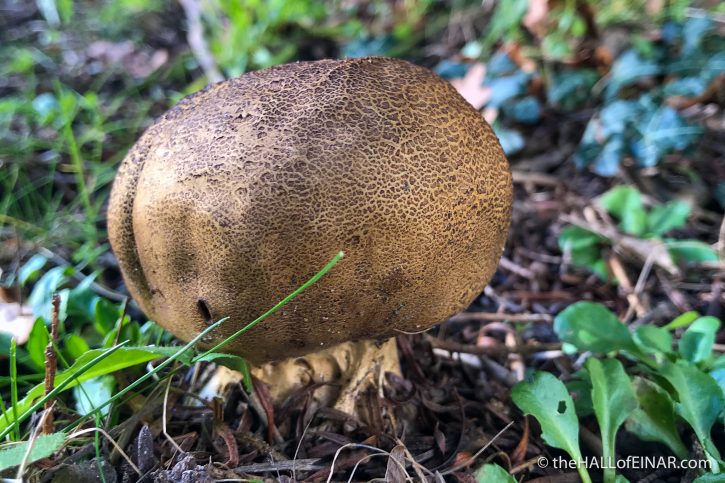
Scleroderma means hard skin and verrucosum means warty (like verrucas). I find the name Scaly Earthball a little disappointing. I decide I’m going to call it the Baked Potato fungus until I find there’s a similar species called the Potato Earthball. Oh well. I’m told that to be sure of the species I need to test what colour it turns if I drop potassium hydroxide on it. How random is that?
I’m off to find out where I can get caustic potash and a pipette in a pandemic. See you tomorrow for another local adventure.
More Fungi
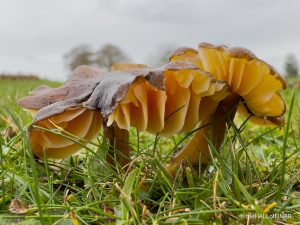 A date with Waxcaps A trip to Somerset to see my friend Martin had the unintended bonus of a walk and a crop of… read more
A date with Waxcaps A trip to Somerset to see my friend Martin had the unintended bonus of a walk and a crop of… read more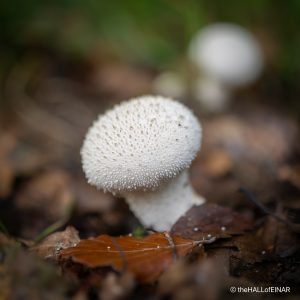 Woodland gem-studded marvels It's 47 years ago today that I first noted down Common Puffballs in my nature notebooks. The tiny gem-like spikes… read more
Woodland gem-studded marvels It's 47 years ago today that I first noted down Common Puffballs in my nature notebooks. The tiny gem-like spikes… read more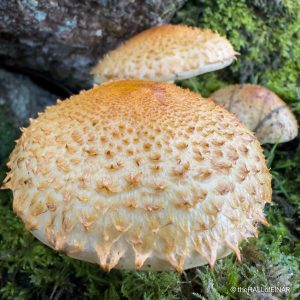 ‘Tis the season for Shaggy Scalycaps It's 47 years today since I first saw Shaggy Scalycaps and wrote about them in blue biro with a pencil… read more
‘Tis the season for Shaggy Scalycaps It's 47 years today since I first saw Shaggy Scalycaps and wrote about them in blue biro with a pencil… read more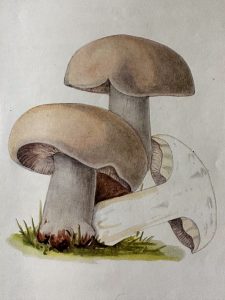 Cry “God for Harry, England and St George’s Mushrooms.” Tomorrow is St George's day, which is an important day in my calendar. That's not because I'm particularly nationalistic, swept… read more
Cry “God for Harry, England and St George’s Mushrooms.” Tomorrow is St George's day, which is an important day in my calendar. That's not because I'm particularly nationalistic, swept… read more Dead Man’s Fingers It's cold on Dartmoor but it's always worth making it to Fingle Bridge. I'm looking forward to a pint in… read more
Dead Man’s Fingers It's cold on Dartmoor but it's always worth making it to Fingle Bridge. I'm looking forward to a pint in… read more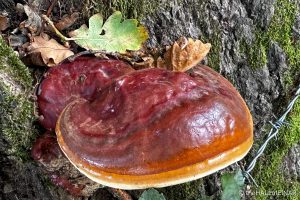 A Red Belted Conk There's the familiar orange-red band on this Red Belted Conk. Lovely, isn't it? Its scientific name is Fomitopsis pinicola. It… read more
A Red Belted Conk There's the familiar orange-red band on this Red Belted Conk. Lovely, isn't it? Its scientific name is Fomitopsis pinicola. It… read more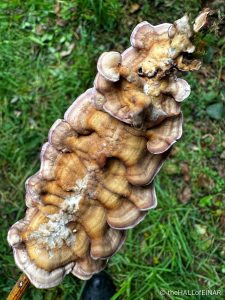 Purple Curtain Crust I do love a good fungusy twig. Here's one with Purple Curtain Crust, Chondrostereum purpureum, rippling on it like a… read more
Purple Curtain Crust I do love a good fungusy twig. Here's one with Purple Curtain Crust, Chondrostereum purpureum, rippling on it like a… read more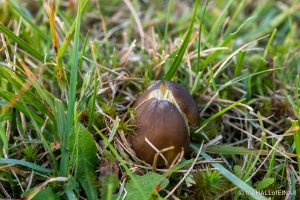 One of Britain’s rarest fungi So you think it doesn't look like much? I think it looks fabulous. It's growing in the short grass around… read more
One of Britain’s rarest fungi So you think it doesn't look like much? I think it looks fabulous. It's growing in the short grass around… read more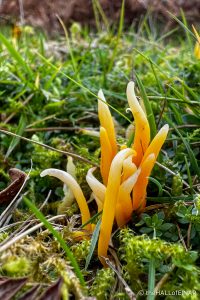 Yellow fingers grow from the short sward There are apricot-yellow fingers of fungus growing in the short sward at Emsworthy Mire. Fabulous, aren't they? They are the… read more
Yellow fingers grow from the short sward There are apricot-yellow fingers of fungus growing in the short sward at Emsworthy Mire. Fabulous, aren't they? They are the… read more